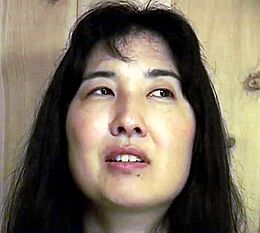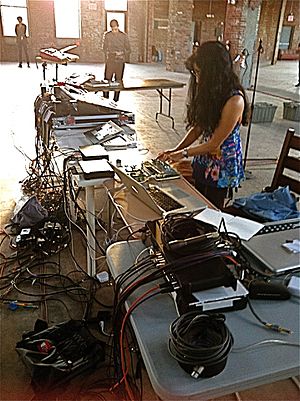Miya Masaoka facts for kids
Quick facts for kids
Miya Masaoka
|
|
|---|---|

Masaoka (c. 2003)
|
|
| Born | 1958 (age 66–67) Washington, D.C., U.S.
|
| Education | San Francisco State University, Mills College |
| Known for | Sound art, musical composition |
Miya Masaoka (born in 1958 in Washington, D.C.) is an American composer, musician, and sound artist. She creates unique music and art using sounds. Her work mixes different styles, including modern classical music, experimental sounds, and traditional Japanese instruments. She lives and works in New York City.
Masaoka often plays a special 21-string Japanese instrument called a koto. She makes its sound even more interesting by using computer software, preparing the strings in different ways, and even bowing them like a cello. She has also created art pieces and performances that use plants, live insects, and special sensor technology. In 2004, her full-length ballet was shown at the Venice Biennale, a famous art event.
Miya Masaoka has received many important awards for her work. These include the John Simon Guggenheim Memorial Fellowship in 2021, the Doris Duke Award in 2013, and the Herb Alpert Award in 2004. She also received a Fulbright Fellowship to study traditional Japanese music and theater. Today, she is a professor at Columbia University, where she teaches visual arts and directs the Sound Art Program.
Contents
Early Life and Education
Miya Masaoka started learning classical music when she was eight years old. When she was in her early twenties, she moved to Paris, France. After returning to the United States, she studied music at San Francisco State University. She earned her Bachelor of Arts degree with high honors. Later, she received her Master of Arts degree from Mills College, where she also won an award for her music compositions.
About Miya Masaoka's Work
Masaoka's art covers many different types of music and media. She has composed pieces for voices, orchestras, and even short films. She has also made special clothes with lights (called LED KIMONO) that respond to movement. She has even explored how insects move, how plants react, and how brain activity can create sounds in her art pieces.
Many groups and artists have asked her to create new works for them. These include famous names like Bang on a Can and Alonzo King’s Ballet. Her orchestral piece, "Other Mountain," was chosen for a special performance in 2013.
From 1989 to 1996, Miya Masaoka led the San Francisco Gagaku Society. Gagaku is a very old type of Japanese court music, with a history going back over 1000 years. She learned this traditional music from Master Suenobu Togi, who was a musician in the Japanese Imperial Court.
Masaoka loves nature and open spaces. This love inspired her to record migrating birds in canyons near the San Diego Airport. This recording became part of her work "For Birds, Planes and Cello." Another piece, "While I Was Walking, I Heard a Sound," was written for 120 singers. In one part of this piece, three choirs and nine opera singers make sounds like bird calls and other nature sounds.
As a koto player, she often improvises, which means she makes up music on the spot. She has performed and recorded with many famous musicians, including Pharoah Sanders, Pauline Oliveros, and Fred Frith.
Masaoka describes her inspiration by saying, "I am deeply moved by the sounds and energy of the natural world. People, history, memory, this geography and soundscape of nature and culture -- from our human heart beat to the rhythms of the moon and oceans -- how infinitely complex yet so fundamental."
In 1999, she started the San Francisco Electronic Music Festival. This festival brings together artists who create music using electronic sounds and technology.
The New York Times newspaper has praised her solo performances, saying she explores "the extremes of her instrument." The Wire magazine described her own compositions as "magnificent" and "essential music."
She has been a faculty member at Bard College since 2002 and has also taught music composition at New York University (NYU).
Selected Works
Miya Masaoka has created many different types of musical and sound art pieces. Here are a few examples:
Orchestral and Large Ensemble Works
- Other Mountain (2013): A piece for a symphony orchestra.
- While I Was Walking, I Heard a Sound… (2003): Written for three choirs singing without instruments and nine solo singers.
- Pieces for Plants (2007): An interactive sound piece where sensors on plant leaves create sounds based on the plant's responses.
- The Long Road (2013): For a string quartet, percussion, koto, and an analog synthesizer.
Works for Smaller Groups and Solo Performances
- Spirit of Goze (1990): For taiko drums, piano, and koto.
- LED Kimono (2009): A performance piece featuring a dancer wearing special clothes with lights that respond to movement.
- Swimming Through Madness (2010): A duet for two 13-string kotos.
- Ritual for Giant Hissing Madagascar Cockroaches (1995-98): A unique solo performance where the movement of cockroaches triggers sounds of their hissing.
- For Birds, Planes and Cello (2004): For cello and recorded sounds from nature.
Works for Dance
- Koto (2004): A full-length ballet featuring the koto and recorded music.
Installations and Exhibitions
- Koto in the Sky (2000): An interactive art installation where lasers beam across buildings, triggered by broomsticks from fire escapes.
- Inner Koto (2005-7): A multi-channel sound installation shown in places like The Kitchen in NYC and the Winter Olympics in Italy.
Discography (Recordings)
Miya Masaoka has released many recordings of her music, both as a solo artist and in collaboration with others.
Solo and Group Recordings
- Compositions Improvisations (1994): Her first solo CD.
- Monk's Japanese Folksong (1998): A recording with her trio.
- For Birds, Planes and Cello (2004): A recording of her piece for cello and field recordings.
- While I Was Walking, I Heard a Sound… (2004): Features 120 singers performing her choral work.
Collaborations
She has also recorded with many other musicians, creating unique sounds together. Some of these recordings include:
- Séance (1996): With Henry Kaiser and Danielle DeGruttola.
- The Usual Turmoil (1998): Duets with George E. Lewis.
- Digital Wildlife (2000): With Fred Frith and Larry Ochs.
- Duets with Accordion and Koto (2008): With Pauline Oliveros.
As a Performer
Miya Masaoka is also a talented performer who has played with many different artists and groups. She has performed with jazz musicians like Steve Coleman and Toshiko Akiyoshi, and experimental artists like Christian Wolff and David Toop.
Films
- 1999 – L. Subramaniam: Violin From the Heart: This film includes a scene where Masaoka performs with L. Subramaniam.
- 2010 – The Reach of Resonance: A film directed by Steve Elkins.
See also
 In Spanish: Miya Masaoka para niños
In Spanish: Miya Masaoka para niños
- Koto


